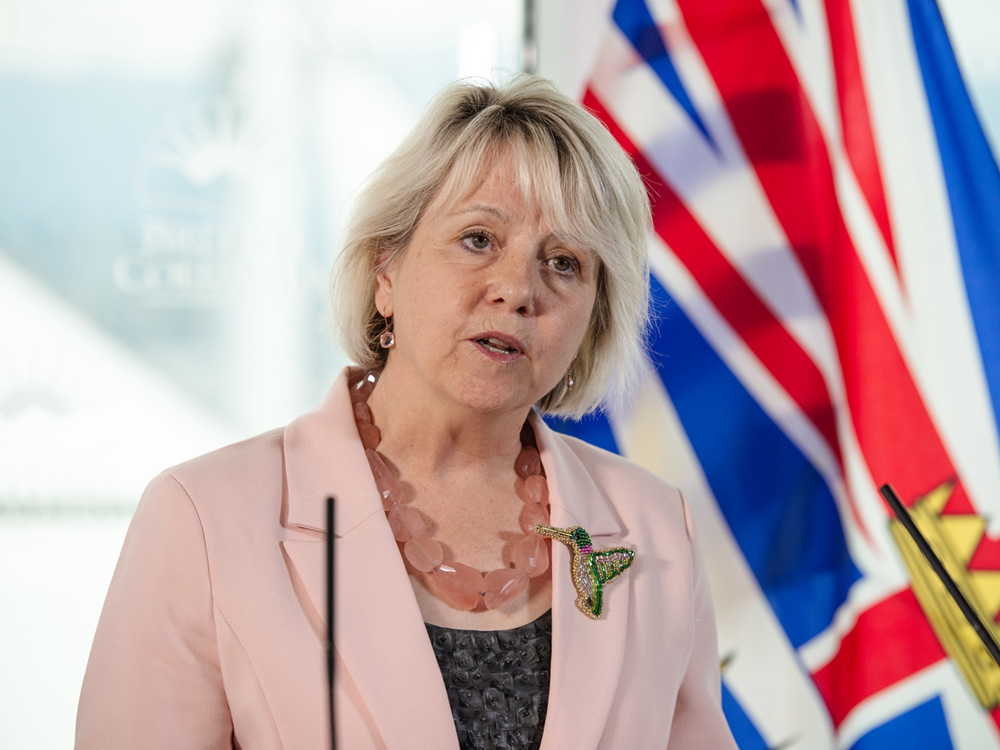Dr. Bonnie Henry wants B.C. to expand its prescribed safer supply program so that more people who use drugs can better access it and clinicians are better equipped to meet patient needs.
Prescribed safer supply is a program for people who use drugs who are at high risk of overdose or death. They are prescribed pharmaceutical alternatives with the goal of reducing their use of the unregulated toxic supply. This can include stimulants or benzodiazepines but the majority of prescriptions are for oral hydromorphone tablets, sold under the brand name Dilaudid.
On Feb. 1 Henry published a review of the program where she said it is “largely positive” and identified several recommendations to improve access to and the impact of the program.
Right now, less than four per cent of the people who need the program are accessing it, says Dr. Alexis Crabtree, a public health physician with the BC Centre for Disease Control.
She estimates around 115,000 British Columbians have an opioid use disorder but only 4,331 people accessed prescribed safer supply in November 2023, the month with the latest available data.
Opioid use disorder is defined by the BC Centre on Substance Use as a chronic relapsing illness associated with high risk of death.
Some of Henry’s recommendations include: allowing clinicians to prescribe diacetylmorphine (pharmaceutical-grade heroin) and powdered fentanyl as part of safer supply; expanding the prescribed medical safer supply model while also exploring a non-medical model; and changing how we think about diversion.
Experts support a non-medical model, but BC doesn’t endorse it
B.C.’s chief coroner Lisa Lapointe also said the province should move towards a non-medical model in a November death review panel. A non-medical model would allow people to access drugs without a prescription from a clinician but would still have checks and balances put in place. One example often pointed towards is a compassion club.
Speaking after Henry at the press conference Feb. 1, Minister of Mental Health and Addictions Jennifer Whiteside said the province is still reviewing the recommendations but will not be considering a non-medical model at this time.
That’s bad news, says Dr. Ryan Herriot, medical director at SAFER Victoria. A non-medical model that sees a controlled but broad distribution of regulated drugs “really is the only way out this crisis,” he says. “We can’t scale treatment in the same way we can scale access to a regulated substance.”
Still, Herriot says he’s glad to see Henry calling for diacetylmorphine and powdered fentanyl, which could be smoked or injected. Making different substances at different potencies available helps bring more patients into the program because oral hydromorphone tablets don’t work for everyone, he says.
Opioid agonist treatment improves quality of life
Henry kicked off the review a year ago to better understand what was happening on the ground and to get a better idea of what unintended consequences the program could be having, she said. The safer supply program was introduced in B.C. in 2020 as a response to the COVID-19 pandemic and the challenges people who use drugs were facing when trying to access harm reduction services and isolate from the virus.
Research on how safer supply works is limited because the program is relatively new and it’s hard to identify what positive impacts it could be having as patients are often also using opioid agonist treatment and having regular contact with a primary care provider, the report notes.
Whiteside referenced local research published last month in the British Medical Journal that found during the first couple years of prescribed safer supply a patient had 61 per cent less risk of death after accessing safer supply once, and a 91 per cent lower risk of death if they got safer supply for four days. The team is already working on crunching more recent data, but it will take time before it is published.
The BC Centre on Substance Use defines opioid agonist treatment as prescription opioids that reduce opioid-related harms and that reduce how often a person uses opioids sourced illicitly. The centre notes that opioid agonist treatment improves people’s mental health, social functioning and quality of life.
Henry also recommended B.C. retire the term “prescribed safer supply” and instead use “prescribed alternatives” to the toxic supply.
‘Recovery must be understood as a process’
Other recommendations touched on social determinants of health, like ensuring safe and secure housing for all, building out a robust primary health care system and investing in the well-being of youth, especially kids from Indigenous, LGBTQ2S+ and racialized communities.
Henry said during her review she heard from people who were distressed because the pandemic and economic pressures had worsened housing insecurity, food insecurity and impacted their mental health which is known to drive up substance use. People are also using stimulants to meet unmet needs, like trying to stay awake so they aren’t robbed or assaulted, or to reduce feelings of hunger.
To save lives during the ongoing toxic drug overdose crisis, B.C. needs to engage people at all stages of their recovery, Henry says. Recovery looks different for every patient, she adds.
“Recovery must be understood as a process,” Henry noted in the report. “Not a false dichotomy of use or abstinence.” It’s a process in “which people improve their health and wellness, live self-directed lives and strive to reach their full potential.”
Part of Henry’s report included a review of safer supply by the Provincial Health Ethics Society.
Speaking on behalf of the society, Alice Virani of the Provincial Health Services Authority said they found safer supply to be ethically defensible and called for B.C. to change how it was framing the possible diversion of safer supply.
Diversion isn’t a good or bad thing, it’s just what happens when people’s needs aren’t met, she says. For example, someone could divert drugs to help a friend who isn’t able to access prescribed safer supply or because the drugs they’re prescribed don’t meet their needs.
“Buried in the report is the embracing of what we call utilitarian ethics, which is the idea of doing the most good for the greatest number of people and accepting some downsides if the trade-off is saving lives,” Herriot says, which he sees as a good thing.
Henry also spoke about how data from the BC Coroners Service, the BCCDC and the police was “reassuring” and didn’t show an increase in the number of youth doing drugs, getting addicted to opioids or dying from them. She said she will continue to monitor the possible risks to youth and minimize them where possible. ![]()
Read more: Health, Rights + Justice, BC Politics

















Tyee Commenting Guidelines
Comments that violate guidelines risk being deleted, and violations may result in a temporary or permanent user ban. Maintain the spirit of good conversation to stay in the discussion and be patient with moderators. Comments are reviewed regularly but not in real time.
Do:
Do not: